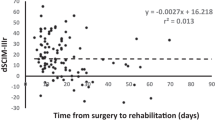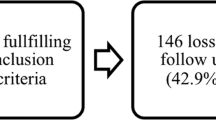Abstract
To determine the factors affecting the outcome of patients with incomplete spinal cord lesions, a retrospective study was performed of all such patients (n = 49) admitted to the neurorehabilitation unit of the National Hospital for Neurology and Neurosurgery, London, over a 2-year period. Disability on admission and discharge as measured by the Functional Independence Measure (FIM), change in disability, presence or absence of neurological recovery, patient age, level of the lesion and length of inpatient stay were the main outcome measures. Data were complete on 39 patients. There were 20 patients with cervical myelopathy, 15 with intrinsic cord abnormalities including syrinxes, 7 with spinal cord infarcts and 7 with other conditions such as tropical spastic paraparesis and hereditary paraparesis. Age ranged from 17 to 88 years (mean 53). Mean duration of stay was 40 days and the duration was related to the diagnosis. Nineteen of the patients made some neurological improvement, while all but one improved on the FIM. This functional gain did not correlate with the patients' age, initial disability or level of the lesion, but was related to the length of stay in the unit, and neurological improvement. We conclude that the needs of patients with progressive incomplete spinal cord lesions due to neurological disease differ from those of patients with acute traumatic spinal cord lesions and are best managed in a neurological rehabilitation unit. Efficacy appears to be related to neurological recovery and the duration of rehabilitation. This study underlines the value of combined neurological and rehabilitation. expertise in the management of this patient group and the need to incorporate both disciplines in planning service provision.
Similar content being viewed by others
References
Perkin GD (1989) An analysis of 7836 successive new out patient referrals. J Neurol Neurosurg Psychiatry 52: 447–448
Young RR, Sarkarati M (1992) Acute and long term care of patients with spinal cord injury or impairment. In: Young RR, Delwaide PJ (eds) Principles and practice of restorative neurology. Butterworth-Heinemann, Oxford, pp 125–135
Ozer MN (1988) The management of persons with spinal cord injury. Demos, New York
Dodds TA, Martin DP, Stolov WC, Deyo RA (1993) A validation of the functional independence measure and its performance among rehabilitation patients. Arch Phys Med Rehabil 74: 531–536
Tennant A, Geddes J (1993) Progress in medical rehabilitation: issues in measurement (application of Rasch models to measurement in rehabilitation) European Rehabilitation Newsletter
Winer BJ (1962) Statistical principles in experimental design. McGraw-Hill, New York
Geldmacher DS, Nager BJ (1989) Spinal cord vascular disease. In: Bradley WG, Daroff RB, Fenichel GM, Marsden CD (eds) Neurology in clinical practice, vol 2. Butterworth-Heinemann, Boston, pp 983–988
Pelser H, Gijn J van (1993) Spinal infarction: a follow up study. Stroke 24: 896–898
Waters RL, Sie I, Yakura J, Adkins R (1993) Recovery following ischaemic myelopathy. J Trauma 35:837–839
Ebersold MJ, Pare MC, Quast LM (1995) Surgical treatment for cervical spondylitic myelopathy. J Neurosurg 82:745–741
Edwards S (1991) The incomplete spinal lesion. In: Bromley I (ed) Tetraplegia and paraplegia: a guide for physiotherapists. Churchill Livingstone, Edinburgh, pp 145–166
Author information
Authors and Affiliations
Corresponding author
Rights and permissions
About this article
Cite this article
Stevenson, V.L., Playford, E.D., Langdon, D.W. et al. Rehabilitation of incomplete spinal cord pathology: Factors affecting prognosis and outcome. J Neurol 243, 644–647 (1996). https://doi.org/10.1007/BF00878660
Received:
Revised:
Accepted:
Issue Date:
DOI: https://doi.org/10.1007/BF00878660




